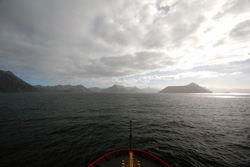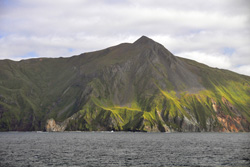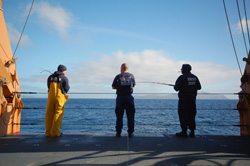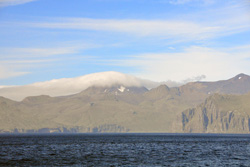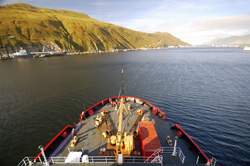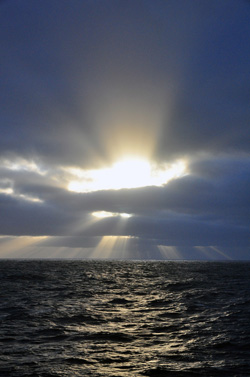September 23rdIt’s 1000 local time, and we’re 45 miles from Dutch Harbor, going fast in a following sea. She’s rolling in a languid corkscrew motion, the quarter-sea boogie in slow time, and the end of this fine trip hoves into sight. Away to port, sunbeams penetrate layered breaks in the clouds and reach in improbable, cinematic shafts of yellow and pale white to the surface of the sea. And I’m feeling the usual nostalgia at endings, at leaving the sea. You can bet there isn’t a single Coastie aboard this vessel who shares that sentiment. As Captain Rall put it, the other two icebreakers in the American fleet, Polar Sea and Polar Star, are icebreakers with research capability, while Healy is a research vessel with ice breaking capability. That being the case, her crew, working in the Arctic without a break since May, have surely done their duty to ocean science. As Dr. Bob has said more than once, the Marine Science Technicians and the other science-support people have gone beyond the call of duty to make our work possible let alone successful—likewise Captain Rall, not only cooperative, but enthusiastic about the science. The other researchers, with their wide-ranging interests, have expressed similar sentiments. And then there are the crew who have kept this vessel and her complex systems going for so long through three separate science missions since the beginning of the season, not to mention laying on four hot meals a day. Intercom: “Fishing call will commence at 1400.” Repeat. Fishing call, no kidding. We’re waiting for an oil tanker to vacate Dutch Harbor so we can enter, might as well fish. For the last several hours we’ve been steaming amid the Aleutian Islands, the most spectacular scenery I’ve witnessed this side of East Greenland. Towering rock islands, beribboned with waterfalls, diving vertical sided into the sea, green meadows climbing toward the arêtes and ridges and hanging valleys left by ice ages, while snow fields and smoky white clouds enhance the other-worldly mood. We lined the bridge windows oohing and awing and extolling the wonder of Unalaska Island and its neighbors. This place doesn’t look real, we agreed, a habitat for trolls and goblins. Plus, the sun—actual sun—is shining. And the sea is bright blue. We got lucky again. “Orcas!” Small ones, females, apparently, or youngsters, lacking those distinctive long dorsals, rolled and sped away toward the land. Little fur seals ran the other direction. Big seals, light-brown lumps lounged on the thin shingle beach at the foot of a cliff. Brian watched the rock faces through binocs. “I should have been a geologist,” he said. It would have been fun to have one aboard to tell how these islands came to be what they are. Intercom: “Fish call is now over. All lines in.” We’re underway again heading for Dutch Harbor, the end of the trip for the science staff, after which, Healy will head for her homeport in Seattle via Kodiak Island. I’m going up to the bridge to watch our arrival. I’ll get back to you. They made a very clean job of mooring against a hard-world concrete wharf in a rubble-strewn, no-frills commercial harbor. The second thing overboard after the dock lines was our garbage in dozens of industrial-strength plastic bags. We hear that not far up the gravel road there is a hotel with a bar. But I doubt anyone will go there. Is that to be the future of the Arctic, a headlong rush for more of the stuff that causes global warming made accessible as never before because of global warming? When I first went to sea on a research vessel (Oceanus), I was so bedazzled by the esoteric instruments, piles of heavy-duty hardware, floats, and spools of wire, and unidentifiable objects seemingly strewn all over the aft deck, by oceanography’s endless, impenetrable acronyms and arcane concepts, and by the cranes, winches, and hard-hat industry going on, I got seasick. When, with subsequent expeditions and the help of patient scientists, I learned to separate the disparate tasks and to sort out some of the oceanographic principles, I was able to reassemble the aspects to recognize the unity of talent, skills, ingenuity, and seamanship required to pull off a voyage like this. Now, to study nature in this way without taking anything from it seems to me to be one of the high levels of human endeavor. However, we don’t want to be too smug about it, because in studying, at least indirectly, the effects of global warming on the Arctic, we burned many thousands of gallons of hydrocarbons, an irony lost on no one. That said, this is still vitally important work. There is a full-on emergency in the Arctic. If it loses its ice in summer, the Arctic will no longer be the Arctic, and the feedbacks and reverberations will be keenly felt by the rest of us south of 66 degrees, 33 minutes North. Time is not on our side, yet for most of us the Arctic remains out of sight and mind. And then there is the pressing threat of oil under the Arctic. Credible experts contend that some ten billion tons—a quarter of Earth’s remaining oil supply—awaits exploitation at the bottom of the Arctic Ocean. Geologists have known this for decades, but they could only peer longingly at their seismic maps, because ice covered the Arctic Ocean. Is that to be the future of the Arctic, a headlong rush for more of the stuff that causes global warming made accessible as never before because of global warming? In any case, even if those figures are exaggerated, precedent for rationality when oil is the issue remains scant, and those of us who held out hope for an Antarctic-style, leave-it-to-nature treaty in the Arctic relinquished them years ago. Climate change and the riches it exposes, along with the geopolitical realignments and militaristic assumptions about national interests that usually attend the presence of oil, have led experts in various disciplines to predict that the Arctic is about to become the most important region in the world. We’re beginning to hear talk of it as the “Fourth World,” which Gail Osherenko in The Age of the Arctic (Cambridge) described as “composed of indigenous peoples who are locked into nations they can never hope to rule.” No one knows just what the future will hold. The dark view is easily at hand. But some of us still hold out hope that rationality will prevail, that we’ll recognize that nature cannot long sustain our level of consumption, and we’ll curtail it. In any case, this sort of at-sea research will continue. Those of us fortunate enough to participate, to learn things, to make new, valuable friendships, and to witness this sublime environment long for the opportunity to return. We hope, too, that this website has provided a pleasing and pertinent glimpse into the wondrous gift of nature we call the Arctic. Further, we hope that, time passing, our title for the site will prove unjustified, and a healthy Arctic will abide forever.
Last updated: October 27, 2010 | |||||||||||||
Copyright ©2007 Woods Hole Oceanographic Institution, All Rights Reserved, Privacy Policy. | |||||||||||||
